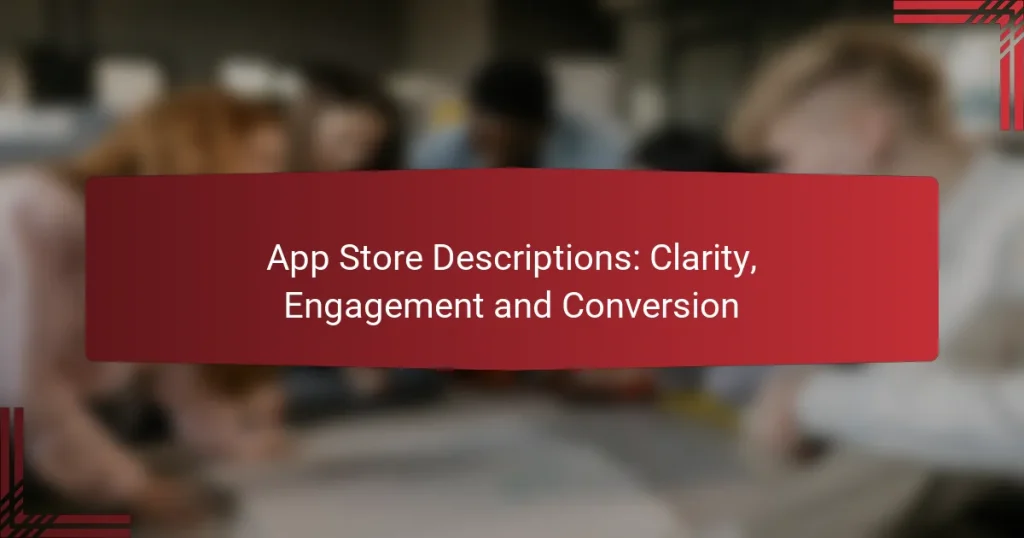App store descriptions play a crucial role in boosting conversion rates by effectively conveying the app’s benefits and engaging potential users. A compelling description not only informs but also persuades users to download the app, enhancing its visibility and overall success in the competitive marketplace.
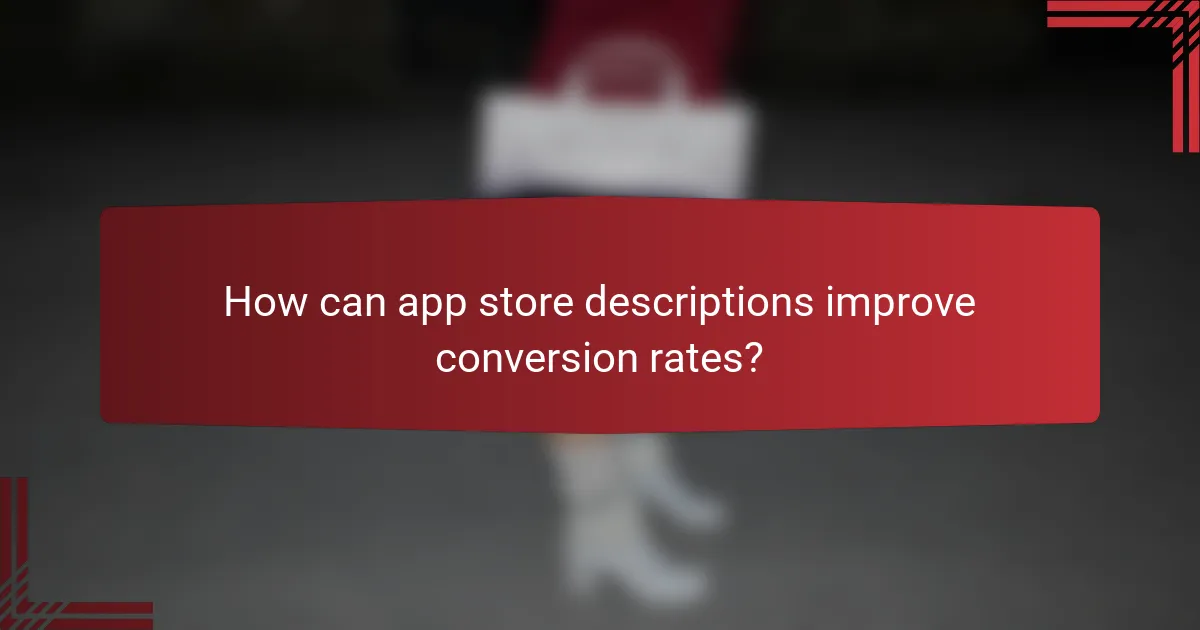
How can app store descriptions improve conversion rates?
App store descriptions can significantly enhance conversion rates by clearly communicating the app’s benefits and engaging potential users. A well-crafted description not only informs but also persuades users to download the app, ultimately increasing its visibility and success in the marketplace.
Clear value propositions
Clear value propositions are essential for capturing user interest. They succinctly convey what makes your app unique and why users should choose it over competitors. Focus on the primary benefits, such as time-saving features, cost-effectiveness, or innovative solutions to common problems.
For example, instead of saying “Our app helps you manage tasks,” specify “Our app saves you 30% more time on daily tasks with smart scheduling.” This specificity helps users understand the app’s value immediately.
Engaging call-to-action
An engaging call-to-action (CTA) prompts users to take the next step, such as downloading the app. Use action-oriented language that creates a sense of urgency or excitement, like “Download now to start your free trial!” or “Join thousands of satisfied users today!”
Position your CTA prominently within the description to ensure it stands out. A compelling CTA can significantly boost conversion rates by guiding users toward immediate action.
Targeted keywords
Incorporating targeted keywords into your app store description improves its discoverability. Research relevant terms that potential users might search for, and integrate these naturally into your text. This practice not only helps with search rankings but also ensures your description resonates with user intent.
For instance, if your app is a fitness tracker, include keywords like “fitness,” “health,” and “workout plans.” However, avoid keyword stuffing, as it can detract from readability and user engagement.
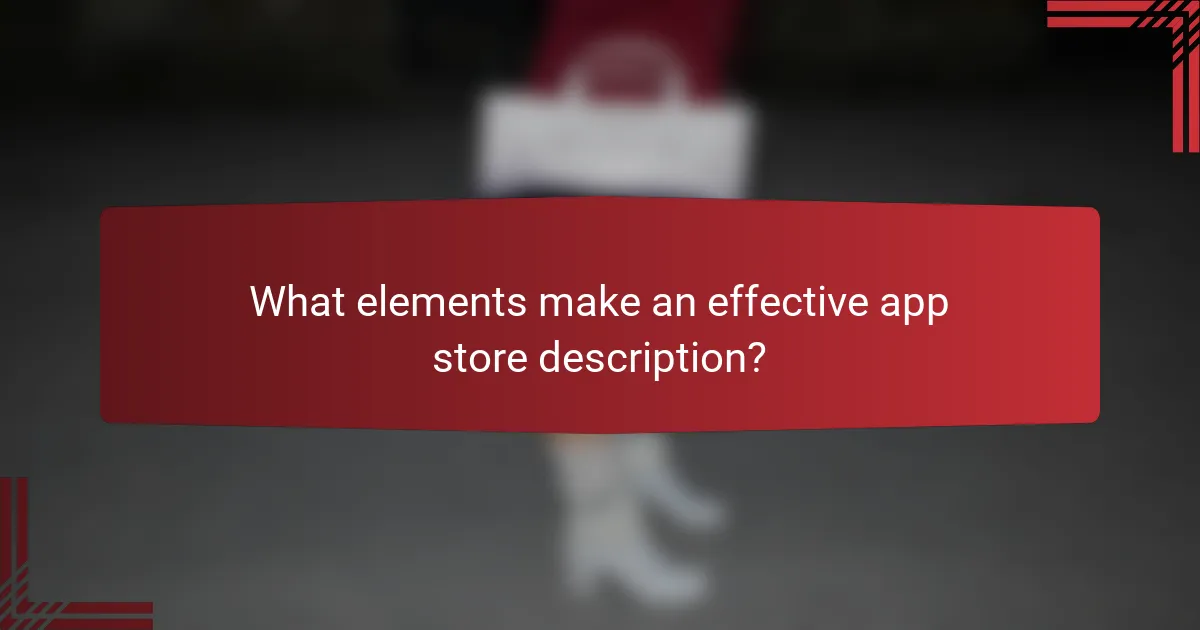
What elements make an effective app store description?
An effective app store description clearly communicates the app’s purpose, engages potential users, and drives conversions. Key elements include compelling headlines, feature highlights, and user testimonials, all of which work together to attract and inform users.
Compelling headlines
Compelling headlines grab attention and encourage users to read further. They should be concise, descriptive, and highlight the app’s main benefit or unique selling proposition. For example, instead of “Fitness Tracker,” a more engaging headline could be “Transform Your Health with Our All-in-One Fitness Tracker.”
When crafting headlines, consider using action verbs and emotional triggers to resonate with your target audience. A/B testing different headlines can also help determine which version drives more downloads.
Feature highlights
Feature highlights succinctly showcase the app’s key functionalities and benefits. Use bullet points or short paragraphs to make this information easily digestible. Focus on what sets your app apart, such as exclusive features, user-friendly design, or integration with other popular services.
For instance, if your app offers offline access, mention it as a key feature. Highlighting 3-5 main features is typically effective, ensuring users quickly understand the app’s value without overwhelming them with details.
User testimonials
User testimonials build credibility and trust, making them a powerful addition to your app store description. Include short quotes from satisfied users that highlight specific benefits or experiences. For example, “This app helped me lose 10 pounds in just a month!” can be very persuasive.
When selecting testimonials, aim for diversity in user experiences to appeal to a broader audience. If possible, include ratings or star scores to reinforce positive feedback and enhance the app’s perceived value.
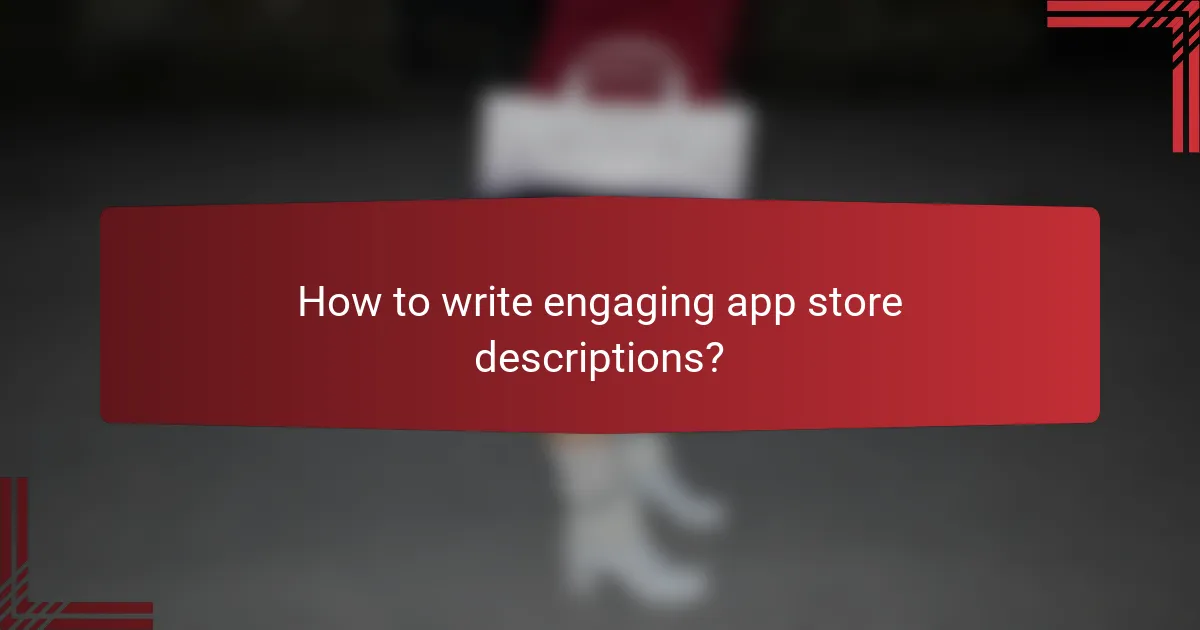
How to write engaging app store descriptions?
Engaging app store descriptions capture users’ attention and encourage downloads by clearly communicating the app’s value. To achieve this, focus on storytelling, integrate visual elements, and use concise language that resonates with your target audience.
Use of storytelling
Storytelling in app descriptions creates an emotional connection with potential users. By framing the app within a narrative, you can illustrate how it solves a problem or enhances the user’s life. For example, instead of simply stating features, describe a scenario where the app improves daily tasks or provides entertainment.
Consider using relatable characters or situations that your audience can identify with. This approach not only makes the description more engaging but also helps users envision themselves using the app in real-life contexts.
Visual elements integration
Incorporating visual elements, such as screenshots or icons, enhances the appeal of your app store description. Visuals can quickly convey the app’s functionality and user interface, making it easier for potential users to understand what to expect. Aim for high-quality images that highlight key features and benefits.
Additionally, consider using bullet points or icons to break up text and draw attention to important aspects. This format allows users to scan the description quickly, improving their chances of engaging with the content.
Concise language
Using concise language is crucial for maintaining user interest in app store descriptions. Aim for clarity and brevity, avoiding jargon or overly complex sentences. A good rule of thumb is to keep sentences short and to the point, ideally under 20 words.
Focus on the most compelling features and benefits, using active voice to create a sense of urgency. For instance, instead of saying “This app can help you manage your tasks,” say “Manage your tasks effortlessly with our app.” This direct approach encourages users to take action.
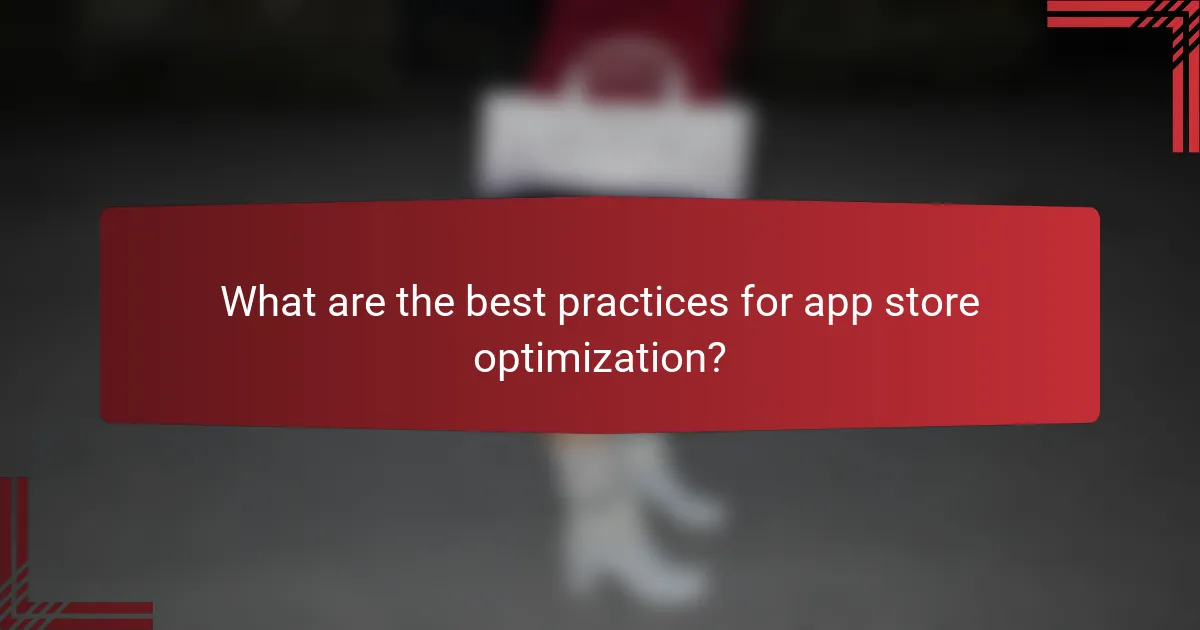
What are the best practices for app store optimization?
Best practices for app store optimization (ASO) focus on improving visibility, engagement, and conversion rates in app stores. Key strategies include effective keyword research, competitor analysis, and regular updates to keep the app relevant and appealing to users.
Keyword research techniques
Keyword research is crucial for ASO as it helps identify the terms potential users are searching for. Utilize tools like Google Keyword Planner or App Annie to discover relevant keywords with high search volume and low competition.
Incorporate these keywords into your app title, description, and tags. Aim for a balance between popular keywords and niche terms to capture a broader audience while maintaining relevance.
Competitor analysis
Analyzing competitors provides insights into successful strategies and areas for improvement. Identify top competitors in your app category and examine their app descriptions, keywords, and user reviews.
Look for patterns in their approach and note what resonates with users. This can inform your own app store listing, helping you differentiate your app while adopting effective tactics.
Regular updates
Regular updates are essential for maintaining user interest and improving app performance. Frequent updates signal to users that the app is actively maintained, which can enhance trust and encourage downloads.
Incorporate user feedback and fix bugs with each update. Consider introducing new features or content to keep the app fresh and engaging, which can lead to higher retention rates and positive reviews.
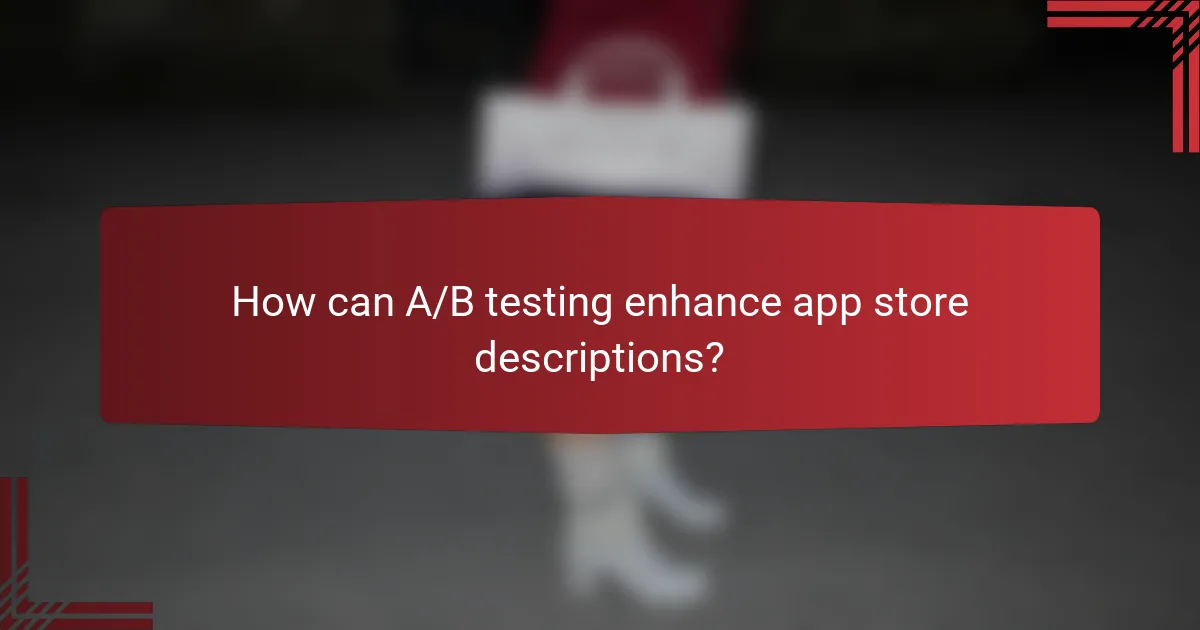
How can A/B testing enhance app store descriptions?
A/B testing can significantly improve app store descriptions by allowing developers to compare different versions and determine which one drives higher engagement and conversion rates. This method involves systematically testing variations of the description to identify the most effective elements that resonate with potential users.
Identifying effective elements
To identify effective elements in app store descriptions, focus on key components such as headlines, feature lists, and calls to action. Experiment with different wording, formatting, and lengths to see what attracts more clicks and downloads. For instance, a concise headline may perform better than a lengthy one, while bullet points can enhance readability.
Consider testing emotional triggers versus straightforward descriptions. Some users may respond better to engaging language that evokes curiosity, while others might prefer clear, factual information about the app’s functionality. Tracking user interactions can help pinpoint which elements are most compelling.
Data-driven decisions
Data-driven decisions are crucial in refining app store descriptions through A/B testing. Analyze metrics such as click-through rates, conversion rates, and user retention to evaluate the performance of each variation. This quantitative approach allows for informed adjustments based on real user behavior rather than assumptions.
Utilize tools that provide insights into user engagement and demographic information. For example, if a particular description appeals more to a specific age group or region, tailor future iterations to better meet those preferences. Regularly revisiting and updating descriptions based on data ensures that they remain relevant and effective in attracting new users.
